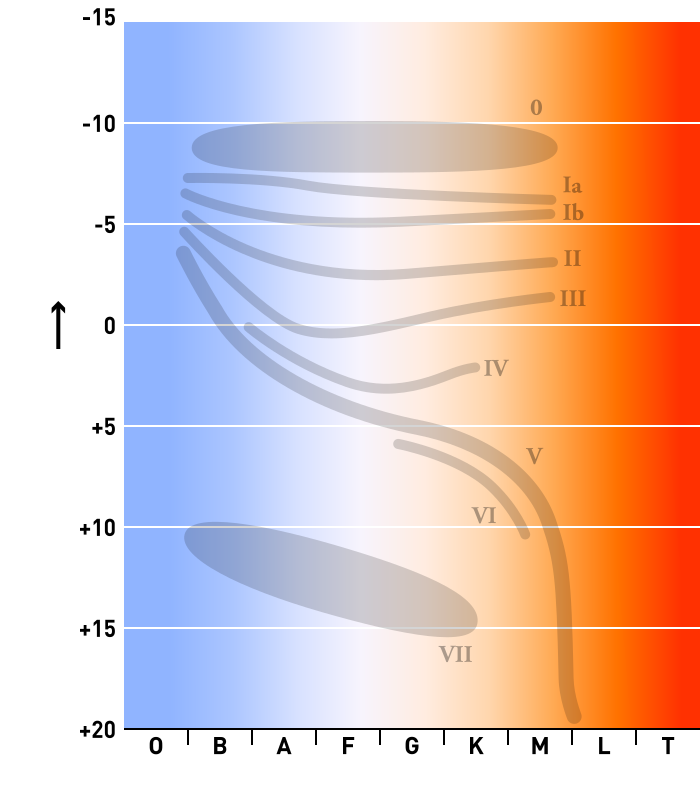Hi,
 what you can see on the picture is extremely cool (hot actually) even that you don´t know it yet. It is called Hertzsprung-Russell diagram and I will try to explain it with the rest of Stellar classification.
what you can see on the picture is extremely cool (hot actually) even that you don´t know it yet. It is called Hertzsprung-Russell diagram and I will try to explain it with the rest of Stellar classification.
So there is first thing I have to clear out: What is Absolute magnitude?
Absolute magnitude describes how bright is star. This of course depends on the distance from which you are looking. It is called absolute because of fixed distance of 10 parsecs (around 32.6 light years). There exists also apparent magnitude which is taken from Earth´s view.
This absolute/apparent magnitude is in logarithmic scale. This means that for every point in magnitude, brightness increases by x2.512. So for 5 points, brightness increases 100 times (2.512^5=100.0226), this corresponds to what was created in ancient Greece. Also it is important to note that negative means more bright.
Absolute magnitude is Y-axis on HR diagram (it can also be luminosity) while X-axis is spectral class or sometimes surface temperature.
Spectral class corresponds with surface temperature, mass, solar radius and its rareness.
There are usually seven types but on the picture you can see nine.
Those seven are OBAFGKM. Where O type is hottest and M coolest with lowest mass.
You can use mnemonic to remember it: Oh Be A Fine Girl (Guy) Kiss Me (I really like this one :D).

And the last thing you need to know about the diagram are those roman numbers. Those are luminosity classes.
VII: those are white dwarfs.
VI: subdwarfs
V: main sequence stars
IV: subgiants
III: giants
II: bright giants
Ib: less luminous giants
Ia: luminous super giants
0: hyper giants! (those are shown on the right picture, blue line is orbit on Neptune and those stars are: blue hyper giant, yellow hg., red super giant and red hyper giant)
So now we can take our Sun and find out what we can tell about it.
Wikipedia says that spectral classification of Sun is G2V.
G: it is spectral class (girl/guy)
on the diagram it is rather on the left and you can see it is yellow.
2: means that Sun is in the upper part of G spectral class, this is only for subdividing those classes where 0 is highest and 9 lowest.
V: (it is 5) this means that Sun belongs to main sequence stars.
Now you can easily find where it stands.
Another example could be 10 Lacertae a star in the constellation of Lacertae.
O9V is its classification.
O: (Oh) you can see it is a super giant but with “only” 9 so it is rather smaller and cooler super giant.
V: again this one is lying in the main sequence so it would belong to upper left corner of diagram.
That´s about it, if you ever check for any star, this classification can be extremely helpful for you.
Dragallur
Note that there is table for spectral classes (taken from wikipedia page stellar classification):
| O |
≥ 30,000 K |
blue |
blue |
≥ 16 M☉ |
≥ 6.6 R☉ |
≥ 30,000 L☉ |
Weak |
~0.00003% |
| B |
10,000–30,000 K |
blue white |
deep blue white |
2.1–16 M☉ |
1.8–6.6 R☉ |
25–30,000 L☉ |
Medium |
0.13% |
| A |
7,500–10,000 K |
white |
blue white |
1.4–2.1 M☉ |
1.4–1.8 R☉ |
5–25 L☉ |
Strong |
0.6% |
| F |
6,000–7,500 K |
yellow white |
white |
1.04–1.4 M☉ |
1.15–1.4 R☉ |
1.5–5 L☉ |
Medium |
3% |
| G |
5,200–6,000 K |
yellow |
yellowish white |
0.8–1.04 M☉ |
0.96–1.15 R☉ |
0.6–1.5 L☉ |
Weak |
7.6% |
| K |
3,700–5,200 K |
orange |
pale yellow orange |
0.45–0.8 M☉ |
0.7–0.96 R☉ |
0.08–0.6 L☉ |
Very weak |
12.1% |
| M |
2,400–3,700 K |
red |
light orange red |
0.08–0.45 M☉ |
≤ 0.7 R☉ |
≤ 0.08 L☉ |
Very weak |
76.45% |



 This type of supernova is explosion of white
This type of supernova is explosion of white  what you can see on the picture is extremely cool (hot actually) even that you don´t know it yet. It is called Hertzsprung-Russell diagram and I will try to explain it with the rest of Stellar classification.
what you can see on the picture is extremely cool (hot actually) even that you don´t know it yet. It is called Hertzsprung-Russell diagram and I will try to explain it with the rest of Stellar classification.

